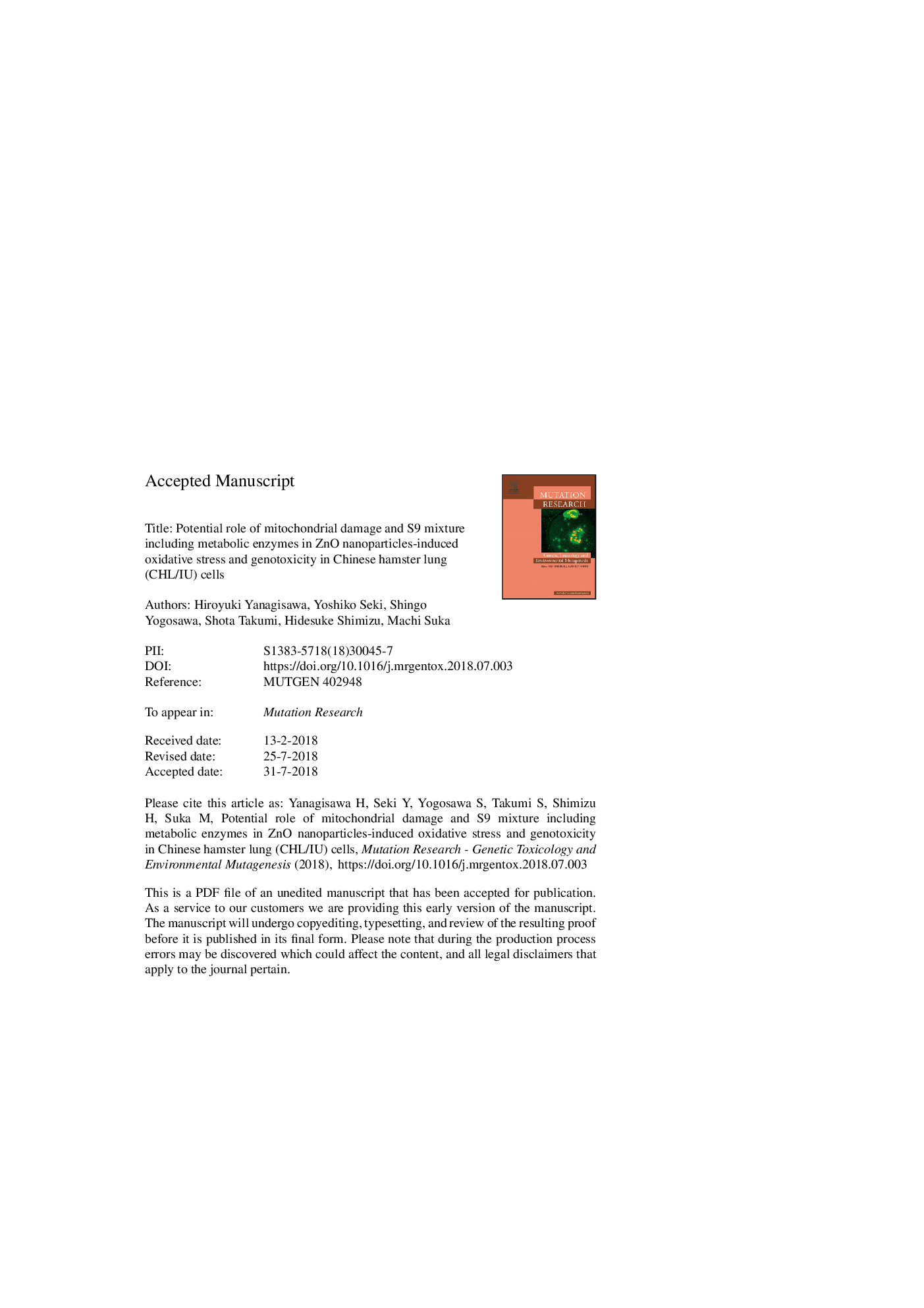| کد مقاله | کد نشریه | سال انتشار | مقاله انگلیسی | نسخه تمام متن |
|---|---|---|---|---|
| 8456176 | 1548539 | 2018 | 46 صفحه PDF | دانلود رایگان |
عنوان انگلیسی مقاله ISI
Potential role of mitochondrial damage and S9 mixture including metabolic enzymes in ZnO nanoparticles-induced oxidative stress and genotoxicity in Chinese hamster lung (CHL/IU) cells
دانلود مقاله + سفارش ترجمه
دانلود مقاله ISI انگلیسی
رایگان برای ایرانیان
کلمات کلیدی
موضوعات مرتبط
علوم زیستی و بیوفناوری
بیوشیمی، ژنتیک و زیست شناسی مولکولی
تحقیقات سرطان
پیش نمایش صفحه اول مقاله

چکیده انگلیسی
The present study was designed to examine genotoxicity induced by 10-40ânm zinc oxide (ZnO) nanoparticles using the in vitro system. The frequency of micronuclei was significantly increased in a dose-dependent manner when cultured Chinese hamster lung (CHL/IU) cells were exposed to ZnO nanoparticles for 24, 48 and 72âh in the continuous treatment method. The maximal frequency of micronuclei was observed in exposure of CHL/IU cells to ZnO nanoparticles at a concentration of 125âμM. The frequency of micronuclei was profoundly enhanced when CHL/IU cells were exposed to ZnO nanoparticles in the presence vs. absence of S9 mixture including metabolic enzymes in the short-term treatment method, demonstrating an increase in the formation of micronuclei by S9 mixture. The maximal frequency of micronuclei was seen in exposure of CHL/IU cells to ZnO nanoparticles at a concentration of 140âμM. Similar results were obtained in chromosome aberrations, particularly structural aberrations. Surprisingly, administration of the superoxide radical scavenger, tempol, completely abolished an increase in the frequency of micronuclei in the presence or absence of S9 mixture, indicating a central role of superoxide radical in the formation of micronuclei. Indeed, reactive oxygen species (ROS) generation was elevated by simultaneous incubation of S9 mixture and ZnO nanoparticles and by exposure of CHL/IU cells to ZnO nanoparticles in the presence or absence of S9 mixture. An electron microscopic examination revealed mitochondrial damage in CHL/IU cells exposed to ZnO nanoparticles, indicating the participation of mitochondrial dysfunction in ROS generation in this setting. These observations suggest that ZnO nanoparticles evoke genotoxicity through superoxide radical-induced oxidative stress derived from mitochondrial damage in CHL/IU cells. S9 mixture appears to contribute to a further increase in genotoxicity through the generation of superoxide radical by metabolic activation of ZnO nanoparticles.
ناشر
Database: Elsevier - ScienceDirect (ساینس دایرکت)
Journal: Mutation Research/Genetic Toxicology and Environmental Mutagenesis - Volume 834, October 2018, Pages 25-34
Journal: Mutation Research/Genetic Toxicology and Environmental Mutagenesis - Volume 834, October 2018, Pages 25-34
نویسندگان
Hiroyuki Yanagisawa, Yoshiko Seki, Shingo Yogosawa, Shota Takumi, Hidesuke Shimizu, Machi Suka,